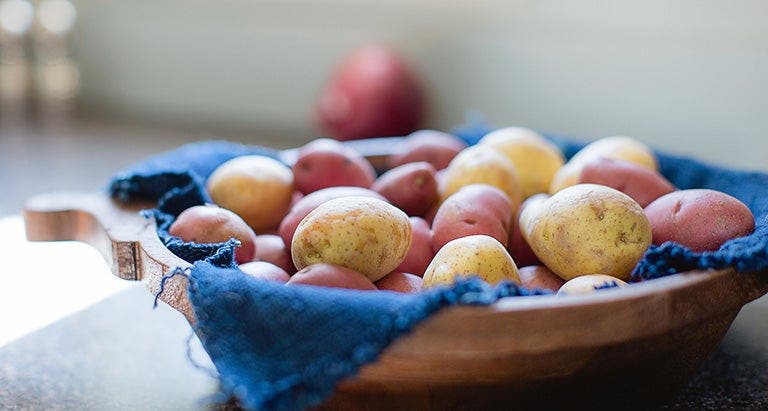Most Valuable Ingredient: Potatoes


The Score
A fact we love about potatoes: They come in so many shapes and sizes. The one most of us conjure up when we think potato is a russet, the standard for baking, mashing and (oven) frying. But Yukon golds are also suitable for mashed and fries, and their buttery, smooth texture needs less seasoning (i.e., fat and calories) to taste special. Small varieties like fingerlings, new potatoes and round reds hold their shape when cooked and are ideal for salads or roasting.
When buying, make sure they’re firm and sprout-free, and that the skin has no greenish tint or blemishes. Wrinkles mean they’re past their prime. Never buy washed potatoes, as they’ll go bad faster.
Sturdy potatoes like russets or Yukon golds will last for weeks, even months, if kept in a cool, dry, dark place like a cupboard or basement (but don’t refrigerate). Exposure to light creates a greenish tint, indicating the growth of a toxin called solanine — the potatoes are still safe to eat, but you’ll have to carefully cut away any green parts. And if you’re concerned about that five-pound bag rotting before you can cook them all, store the bag with an apple tucked inside; the spuds should hold for at least eight weeks. More delicate varieties, like new and red-skinned potatoes, should be consumed within one week. Whatever you do, don’t store potatoes near onions: When kept close together, they emit gases that will make both spoil sooner.
The Stats
An average potato, eaten with the skin, provides 45 percent of the daily requirement of Vitamin C and is a better source of potassium than bananas. It’s also a good source of fiber, iron and magnesium.
Unless you’re buying an heirloom variety at a farmer’s market, potatoes are hard to beat price-wise. When bought individually, they generally cost around $1 a pound, but five-pound bags are $2.50 to $4.
In Play
As often as possible, eat the potato with the peel — just rinse and scrub. While it’s not true that all the potato’s nutrition is found in the peel, much of the fiber is, which aids digestion and helps you feel full longer.
Always cut away any blemishes, eyes or green areas.
If you’re cutting potatoes to be cooked, discoloration may occur as the insides are exposed to oxygen — this isn’t harmful, but it’s not as visually appealing. The simplest solution: As you cut them, put the potatoes into a bowl of cold water.
